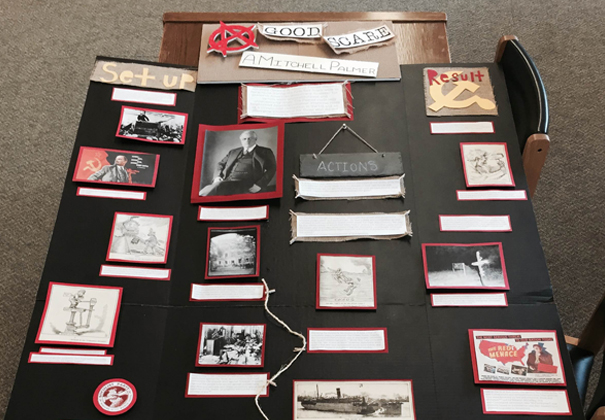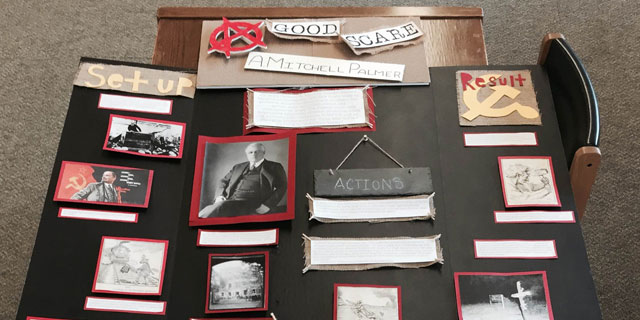
Initiated by Mr. Meyers approximately 15 years ago, every year Fieldston holds a history fair for sophomores in the context of National History Day. The fair revolves around a different theme every year, and this time the central motif was the role of leadership in history.
“This is a chance for intellectually minded students to compete,” Mr. Cullen said, “and it also gives students a creative outlet, an alternative to doing things like writing essays or taking tests, or the usual ‘fare’ of history courses.”
The projects range from posters to documentaries to websites to essays, and each teacher assigns their own limitations on the time period during which students present. Outside of those boundaries, students are free to choose how to and what to present. Mr. Kleinman said that for a presentation, “Visuals tell the story, and visuals present more information than text could, which is limited by a word count.”
When looking at various projects, Mr. Kleinman likes to ask himself, “Can I read your project, as I would an essay, visually?” As in a research paper, he looks for a developed thesis and an organized presentation.
“We’re looking for two core things,” Mr. Cullen explained. “One is some kind of a creativity— broadly defined— usually this is a matter of visual flair, or some kind of presentation that frames an issue in a compelling way… So we’re looking at people who are sort of able to present things in a compelling way, but we’re also looking for intellectual substance in terms of the argument they make, and how you make an argument with pictures, or how you tell a story in a non-narrative mode.”
Mr. Meyers said that students’ effort and enthusiasm as well as relation to the year’s theme were also weighed when deciding the overall grades.
The students create projects that, if chosen by the 10th grade history teachers at Fieldston, advance to New York City History Day, an annual March event. The NYCHD consists of students from all over New York, presided over by a panel of judges. Those who are elected to advance further make it to New York State History Day in April, and lastly National History Day is in June.
The teachers have a limited number of presentations that can be selected from each category. Therefore, the more students who write essays, for example, the less likely each one is to be chosen because of the generally raised competition.
At the State level, at least for documentaries, the students would present their work and then talk to the judges. For poster presentations, the judges just walk around and view each one in a gallery.
According to Mr. Cullen, Fieldston tends to do well in the City division, and “we occasionally have folks advance to State level, and every once in a very while we have someone who makes it to the National level.”
Various students who have participated in the fair spoke of room for improvement. For example, because the fair is held in the commons, the presentations tend to be crowded together tightly. The ensuing chaos makes it difficult for students to present their work, and they feel that they have not been able to say all that they needed to. Some have suggested using the gym instead, like the annual Science Expo, which would allow for a smoother process overall.
Some also feel it would be beneficial to work with students outside of one’s own class, because from a pedagogical perspective, each student from a different class has a different input from which others could learn.
Mr. Meyers adds, “Although we [the history teachers] are not so thrilled about the competitive aspect, we participate in National History Day to give students an opportunity to share their scholarship in public. Athletes and performers get to share their achievements with parents and other students, while historical scholarship is often only shared with the teacher. The National History day is, in a sense, a form of ‘varsity academics,’ where students get to share their efforts in public, and enjoy the work of students from many other schools. It is also an opportunity to work in groups and to explore new media for communicating ideas.”
The following Fieldston students have been chosen to advance to further history fair(s):
Individual essay
Ethan Schondorf: Tecumseh
Sarah Lyon: Whitman
Alex Hsi: Struggle for Leadership at Valley Forge
Individual website
Sophie Schnell: Grimke sisters
Eve Herzog: Leadership at Valley Forge
Individual exhibition
Lucy Pruzan: Mercy Otis Warren
Alie Brussel Faria: Margaret Sanger
Group documentary
Asher Muldoon, et al: Alexander Hamilton
Emma Mitnick, Nina Redpath, Sydney Cameron: Abigail Adams/Dolley Madison
Mathew Gellman, Matt Rubits and Kai Nelson: New Deal
Group website
Alex Goldman and Isabella Astrachan: Tecumseh
Saoirse Maher-Greene and Keerti Gopal: Crazy Horse?
Group Exhibition
Lena Church and Liz Weinstein: John Brown and Nat Turner
Ben Smith and Jacob Morris: Baron von Steuben
Jessie Morris and Beth Awano: Red Scare






